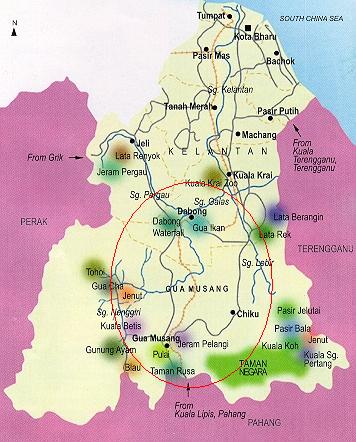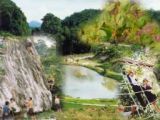
MAPS OF GUA MUSANG
Gua Musang is a town and territory (jajahan) in Kelantan, Malaysia. It is the largest district in Kelantan. Gua Musang is administered by the Gua Musang District Council. Gua Musang district is bordered by the state of Pahang to the south, Terengganu to the east, Perak to the west and the Kelantanese districts of Kuala Krai and Jeli to the north. It is a small railway town at about 160 kilometers south of Kuala Krai. Gua Musang is represented by Tengku Razaleigh Hamzah in the Dewan Rakyat (Hall of the People). The town lies on the railway line from Kota Bharu to Gemas.

Gua Musang literally means "Cave of the Fox". On the eastern side of this town stands Bukit Gua Musang, a barren hill of rocks and deceptive stone-steps running 105 meters high. It stands in a commanding position, with a huge cave running into its interior and is about meters away from the other green tree-covered hills. From a distance, this hill looks like a stone pillar with a big crack which nearly splits it vertically into two equal halves. Between the hill and the town, there runs a railway track.

It was believed that long ago this town was inhabited by some superstitious hunters who made offerings of animals in front of the cave of Bukit Gua Musang. One afternoon a raging storm broke out and the huts of the hunters were destroyed. At the height of the storm a bolt of lightning struck the summit of the hill and nearly split it in two. The hunters, believing that the God of the Cave was angry with them, knelt down and began to pray. As they were praying they saw a huge pack of foxes (or musang in Malay) running into the cave. At once, they seized their bows and arrows and lay in wait for the foxes. They waited the whole evening but the foxes did not emerge, not even when the storm had stopped. From then on, the inhabitants called the cave Gua Musang.
A month after this strange event, seven young hunters climbed the hill but only one came back alive. He told the villagers that when he and his six companions were halfway up the hill, a length of stone staircase appeared before them. They climbed the staircase and upon reaching the summit they found a tree, under which, stood a bowl of pure water. The young men, with the exception of one, drank the water in the bowl to quench their thirst. Before the others could persuade him to drink, the bowl vanished. They grew afraid and quickly began to descend. Suddenly a blood-chilling cry was heard. The hunter turned quickly but it was too late! His six friends had disappeared from sight. He rushed down the slope but there was no sign of any dead bodies at the bottom of the hill.
He concluded that the "God of the Cave" had taken his friends and had spared him because he had not drunk the water in the bowl. Most of the villagers did not believe the young man's story. They were sure that the other six must have slipped and fallen, but the bodies of the missing hunters were never found.
The small village of Merapoh in Pahang which is just south of Gua Musang serves as a popular starting point for those who want to scale Gunung Tahan. Another interesting place to visit in Gua Musang is a Buddhist temple in Pulai, which is purportedly 400 years old. Nenggiri River is a favourite among those who enjoy river rafting. There is also a rafting race, called Nenggiri Challenge. Archaeological sites can be found in caves, such as Gua Cha, Chawan and Jaya, which are situated along the river.